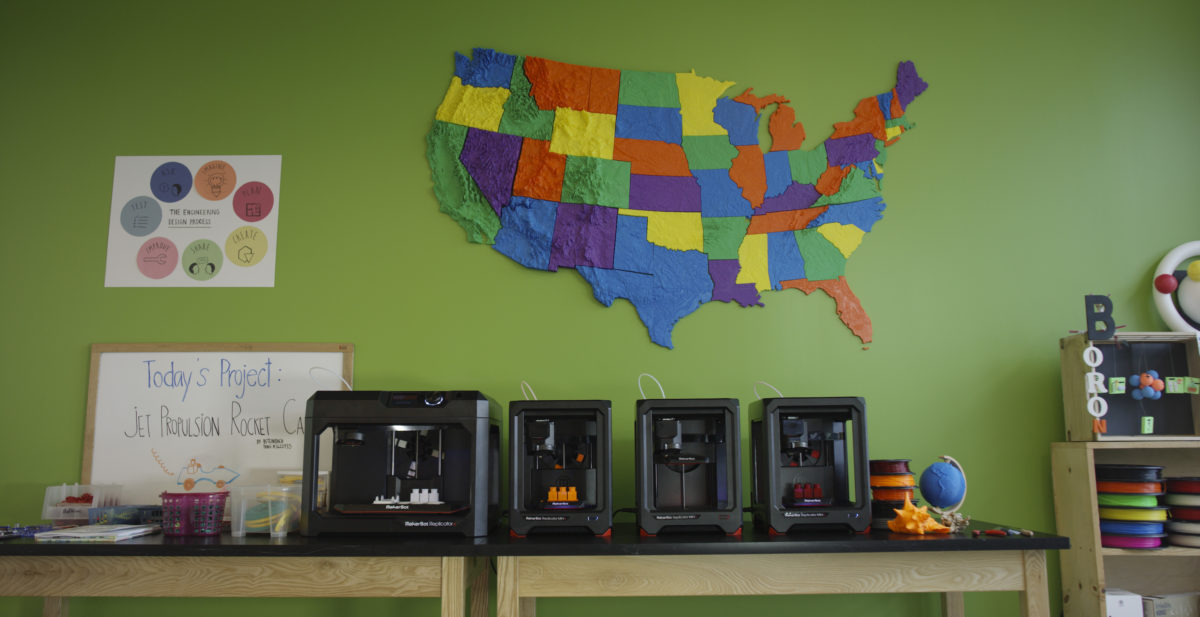MakerBot held a product launch event Tuesday at its headquarters in MetroTech.
The announcement comes after a tough last 18 months, with management shakeups, layoffs and the shuttering of its Industry City factory in favor of one in China. Can MakerBot bounce back?
The occasion was in the Apple mold (but no black turtlenecks, thankfully), with lots of videos and demonstrations showcasing MakerBot’s new product lineup. On display: the company’s new software, MakerBot Print, a revamped version of its Replicator+ 3D printing machine and the Replicator Mini+, an update on its more compact printer.
With its new products, the company is aiming to bolster two segments of the market. Companies such as Manhattan-based home security system maker Canary and Dallas-based industrial design firm Gossamer — both of which presented their latest work at the event — use MakerBot printers for product development.
On the other end, there are MakerBot’s K-12 education customers, many of whom are just starting to learn about 3D printing. The company seeks to cater to each market’s specific needs while offering competitive price points. The Replicator Mini+, geared toward schools, costs $999, while the Replicator+, which has more industrial applications, is $1999.
“This is a very longterm play for us,” CEO Jonathan Jaglom said. “We want to get as many printers out there as possible.” (We wrote about Jaglom’s first 90 days at MakerBot last year.)
The industrial offerings on display included MakerBot Print, the company’s upgraded software, which now enables users to import the CAD files commonly used in industrial design and includes tools for separating projects into smaller print jobs. Then there’s Tough PLA, which is a hardier, less brittle version of the plastic commonly used in 3D printing. Its greater flexibility suits it to designs that require hinges or interlocking parts. (This reporter had way too much enthusiasm testing out balls and sockets made from standard PLA and Tough PLA, as seen in the video below.)
Education turned out to be a strong theme at the event. The segment makes up the bulk of MakerBot’s business, spokesperson Josh Snider told Technical.ly, at more than 60 percent.
Drew Lentz, the manager of MakerBot Learning, the company’s education department, spoke about MakerBot’s efforts to get more teachers using its products. Last year, the company came out with a guidebook to using its machines in the classroom, but it turned out not to be sufficient for many teachers who were just starting to familiarize themselves with 3D printing.
“They told us, ‘You guys are great, but you’re not teachers,'” Lentz said.

Since then, MakerBot has made a vigorous effort to draw teachers in. This summer, the company held education-focused events in New York, Chicago, San Francisco and Washington, D.C. MakerBot then invited attendees to join a task force devoted to developing better educational materials for its products. As a result, MakerBot’s Thingiverse, its free online hub for 3D printing resources, now includes some 100 lesson plans for educators, and more are in the pipeline. The main hurdle the company faces with teachers, is simply enabling them to set up the printer without hassle. In many cases, schools purchase the products without training teachers on how to use them, so instead of being a cool new resource, the printer becomes a white elephant.
“I can’t tell you how many teachers have told me they have a 3D printer but don’t know what to do with it,” Lentz said. “I’ve even seen printers in boxes under the table.”
The company’s latest educational efforts have begun to catch on, including in its Brooklyn home base. One of the event’s featured presenters was Carlos Varas, who teaches technology at P.S. 161 in Crown Heights, mainly to third-, fourth- and fifth-graders. Varas showed off a few of the projects from his lessons, including a model of a Minecraft castle, which he uses to teach the concepts of perimeter and area, and a carbon-dioxide powered mini-car, whose designs his fifth-graders develop and then put to the test in a race.
3D printing, Varas told Technical.ly, has turned out to be an effective way of exploring a variety of mathematical concepts and skills, from spatial reasoning to decimal place value. The new Replicator Mini+, he said, has the benefit of being quieter and faster than the previous model, which allows him to print models for his students more efficiently.
“In the beginning, there was disappointment, because it didn’t have reliable output,” Varas said. “Then you lose the kids. But now that it produces consistently and reliably, there’s total buy-in. They already come in the door interested, asking what they can print.”

The company’s next step in the education market, according to Snider, is signing up more colleges and universities, such as NYU Tandon, which is one of MakerBot’s customers. It’s a tricky space, he explained, because their needs are closer to those of MakerBot’s more industrial customers — if not greater, in some cases — than K-12 schools. But it’s a challenge the company is keen to take on, in large part to show how sophisticated 3D printing has become from its early hobbyist days.
“We’ve grown up from Yoda heads and Elmos,” Snider said.







